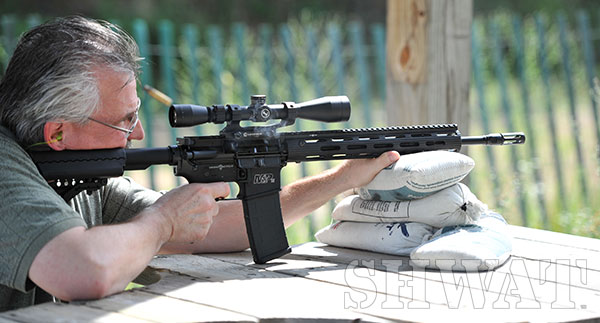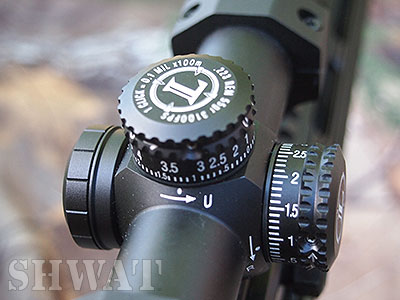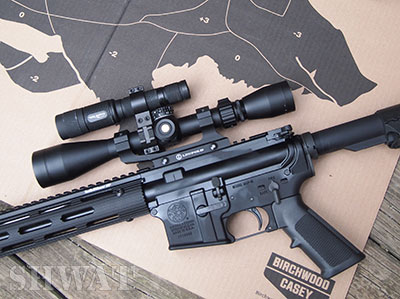
American optics maker Leupold and Stevens, more commonly referred to as just “Leupold,” has been a significant player in the tactical optics market for several years, though it hasn’t received the attention of some other manufacturers. It was also the first to jump into the tactical hog hunting optics market a couple years ago when it debuted the VX-R 1.25-4 Hog Scope, a fine optic that has helped me take a good number of hogs.
Among Leupold’s newer tactical offerings is the Mark AR Mod1 3-9x40mm scope. Recently, I had three separate sessions with this optic, specifically the illuminated, Firedot-G TMR model, including a session after dark to judge its night hunting capabilities. Made for the 5.56mm/.223 Rem AR family of rifles, the Mark AR Mod1 is a quality scope that transmits light and images very well, and is capable of great accuracy.
It won’t ruin a bank account, either.
I mounted the Mark AR Mod1 onto a Smith and Wesson VTACII rifle, using Leupold’s Mark 2 Integral Mounting System. The Mark 2 is a great mounting solution. The aluminum IMS cantilever design mounts directly to a rifle’s Picatinny rail, and put the scope at the right level for my eye relief. It also provides for a solid cheek weld to the stock, on the shooting bench and offhand. No need for risers. Once in place on the rails, the mount is secured by tightening half-inch nuts. The integral rings accept a one-inch scope, and are secured with four Torx screws.
The Mark 2, by the way, also puts the scope at a good height for keeping the back end of the optic out of the way of the AR’s charging handle.
 The elevation and windage knobs have a double row of deep serrations around the outer edge for firm grip. They click positively and cleanly. As marked on the windage knob, the scope is set for 1 click equaling 0.1 mil at 100 meters (not yards) when using 55 grain .223 Rem loads at 3,100 feet per second.
The elevation and windage knobs have a double row of deep serrations around the outer edge for firm grip. They click positively and cleanly. As marked on the windage knob, the scope is set for 1 click equaling 0.1 mil at 100 meters (not yards) when using 55 grain .223 Rem loads at 3,100 feet per second.
On the left side of the scope tube is the battery compartment to provide power for the illuminated reticle option. The cap unscrews and a CR 2032 3-volt battery is inserted inside. Initially, the cap itself came off and went on very hard. I ended up putting a tiny smudge of lubricant along the inner edge of the threading, then screwing on and unscrewing off the cap to work the lube into the threads. Problem solved.
The power ring on the AR Mod1 turns a little stiffly. Not terrible, but stiff. Of course, it was new in the box and will no doubt loosen with more use.
The reticle of the AR Mod1 is slightly different from any other reticle I can recall using. At first glance, it looks much like a Mil Dot reticle, and it is similar. But Leupold calls it their Tactical Milling Reticle, the “TMR” in the model name. The subtends on the TMR work just like all existing mil dot reticle subtends, but Leupold says they’ve made theirs even more accurate because, “the TMR reticle offers areas of .2 mil subdivisions to precisely measure the common one meter target quickly from 500 to 1,000 meters and beyond. This has previously been the most difficult task in long-range shooting, since this entire range lies in the span between one and two mils. The position of the .2 mil subdivisions are intentionally placed on the periphery of the fine crosshair in order to keep the central area clutter free.”
Essentially, the scope’s subtends are spaced the same as a standard mil dot. But they are very thin lines not dots, thereby giving you greater precision for sighting and ranging.
I initially zeroed the scope at 30 yards. At first, it was hitting way left and high, and I pretty much clicked and shot my way to the bullseye. It took only eight shots and my bullets began grouping nicely on the center black.
Then I shifted my range to 100 yards, and I was dead on. That, I thought, was pretty impressive, as I usually have to make adjustments when going from shorter to longer range zeros on a new scope.
So then it was time for some fun shooting, plinking at targets large and small, some of the ground, from 30 to 100 yards, and in various lighting conditions. In bright sun, the lens coatings on the AR Mod1 cut the glare appreciably, and made accurate shooting very easy. The images are very sharp, too. At 100 to 125 yards and at 9 power, I could easily make out separate stems of grass.
I went from these bright conditions to a very deep shaded woodlot, and all images were still very crisp, the edges clear, the light transmission first rate. With any scope, the lower power magnifications produce the better light transmission, and with the AR Mod1, I found the 3 to 5 power range optimum for use in deep shade.
My last test was a night hunting event—minus the shooting. I live in Wisconsin, and while night hunting is legal in some instances (reading the applicable sections of the hunting reg book is an exercise in confusion), people here associate night shooting with deer poaching. Any shots after dark usually bring law enforcement on the run.
 Still, I do a good deal of night hog hunting in places like Texas, and I wanted to see how well the AR Mod1 handled the dark. For my test, I went to a friend’s farm miles away from the lights of my city. I used two targets supplied by Birchwood Casey, the Wild Boar Silhouettes. On a cardboard backing, the black silhouettes are roughly the size of an 80 pound hog. I placed one target at approximately 60 yards and out in the open, and another one at 120 yards, tucked into a very dark space beneath the limbs of a pine tree.
Still, I do a good deal of night hog hunting in places like Texas, and I wanted to see how well the AR Mod1 handled the dark. For my test, I went to a friend’s farm miles away from the lights of my city. I used two targets supplied by Birchwood Casey, the Wild Boar Silhouettes. On a cardboard backing, the black silhouettes are roughly the size of an 80 pound hog. I placed one target at approximately 60 yards and out in the open, and another one at 120 yards, tucked into a very dark space beneath the limbs of a pine tree.
I attached a Nite Hunter 300 lumen green LED light to the rifle, and shined my “hawgs.” As I expected, the 6o yard silhouette in the open, and with some moon light, showed up like a champ; the AR Mod1 crosshairs were easy to find and place on the kill zone.
More impressive, the hog silhouette at 120 yards in that very dark place was equally easy to pick out and zero in on. Had these been real hogs, the AR Mod1 would have let me tag them hard and fast. That isn’t always the case—some optics work fine during the day, but take on an opaque glare when used at night with a light. Not so the AR Mod1, which grabbed all the available light and made my hogs extremely visible.
The eye relief on the Mark AR Mod1 is rated as between 3.6 and 4.3 inches. My set up comes in right at 3.75 inches of eye relief. Somewhat close, but fine for a low-recoiling rifle like a .223. Sturdy and relatively compact, the 12.6-inch long scope weighs in at just under 12.5 ounces.
Leupold lists the Mark AR Mod1 3-9x40mm scope, with the illuminated, Firedot-G TMR reticle, Product #115370, at $549.00 suggested retail. Amazon has the scope available for $420, Optics Planet for $439. In a world of $1,500 and $2,000 tactical scopes, the AR Mod1 more than holds its own, and with a street price of under $500 represents quite a bargain.
Leupold and Stevens:
http://www.leupold.com/
Leupold Mark AR Mod1 3-9x40mm scope, illuminated, Firedot-G TMR model
http://www.leupold.com/tactical/scopes/mark-ar-riflescopes/mark-ar-mod-1-3-9x40mm/
Mark 2 Integral Mounting System:
http://www.leupold.com/tactical/mounting-systems/integral-mounting-systems/mark-2-ims-1-integral-mounting-system/

